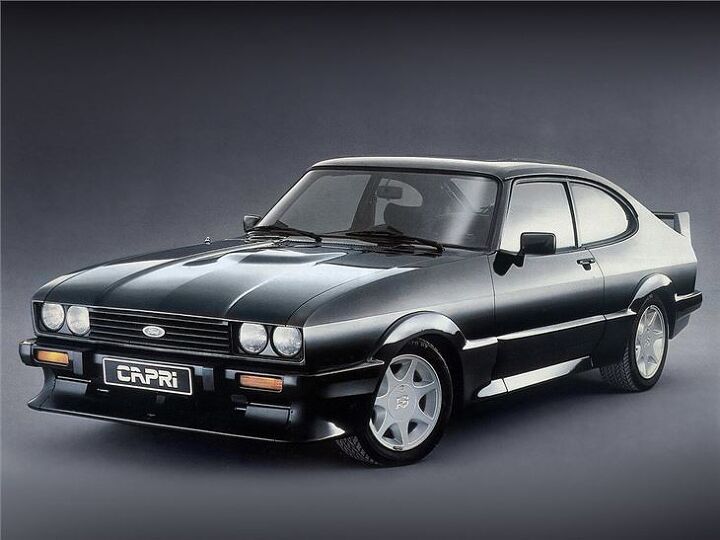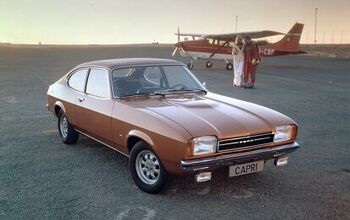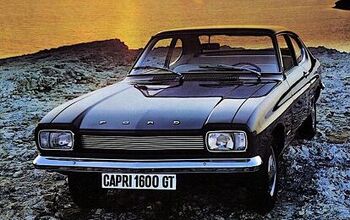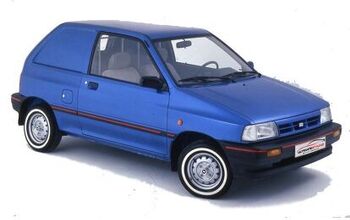Rare Rides Icons: The Ford Capri, a European Mustang (Part III)

Today we conclude the Ford Capri’s story with its third and final generation. After the Mark I’s promising start as a simple and affordable sporty coupe, the Mark II went a bit too soft and comfortable and diverged into many different trims as Ford tried to appeal to a wider audience.
“We can fix it!” exclaimed Ford. Time for Capri Mark III.
The Mark II Capri’s boxy early Seventies styling looked fairly dated by the latter part of the decade and needed a rework. Sales had been on the decline since the Mark II was introduced, a secret sign of things to come for every mass-market coupe. Instead of designing an all-new Capri, the Mark III was a rework of the Mark II. The project was known as Carla within Ford and made use of styling debuted on a Capri show car at the Geneva Motor Show of 1976.
That year, Ford displayed a modified and updated Capri II. It wore a front end similar to the contemporary Escort RS2000 and was known as the Capri Modular Aerodynamic Concept. With badges reading “MA/PF-11,” the concept looked a bit like a Saab 900. Most notably it focused on aerodynamic lines, had a small rear spoiler, a front end that lowered to a leading edge, and quad-enclosed headlamps.
The concept’s general look came mostly to fruition in the Mark III, with the exception of the aero wheels and enclosed headlamps. The black slatted grille of the III was a new family design feature on Ford’s European lineup, as was its sculpted rear lamp design. The shape was penned by Ford design director Uwe Bahnsen, who was responsible for the Mark II Capri, as well as the European Escort, Sierra, Scorpio, and Transit.
Mark III wore a more serious expression than its predecessor, with the edge of its hood pulled down over the top of the headlamps. BMW made use of that trick later to great effect. The Mark III’s wheelbase grew very slightly to 101 inches (100.7″ prior), while its width increased from 66.9 inches to an even 67 inches. Height decreased in a nod to sleekness and aerodynamics, dropping to 51 inches from 53.4. Overall length stayed about the same as before at 167.8 inches, though weight increased with modernity (about 100 pounds no matter the engine and trim), and ranged from 2,227 to 2,688 pounds.
When it entered production in March of 1978, the Mark III continued engine and trim combinations from the Capri II. The sportiest model was the 3.0 S, but the Ghia with the same engine, softer characteristics, and an automatic saw better sales in the United Kingdom. It was the height of the personal luxury coupe, after all. At the entry level was a 1.3-liter inline-four from the Crossflow family, alongside 1.6- and 2.0-liter Pinto inline-fours. The smallest V6 on offer was the 2.0-liter Cologne, joined by 2.3- and 2.8-liter Cologne brethren. The top tier for a while during the Mark III run was the 3.0 Essex V6, but more on that in a moment. For 1983 the old four-speed manual was replaced by a five-speed, while the three-speed C3 automatic remained the same throughout the run.
Sales were promising at debut for the Mark III, and the well-equipped coupe proved a high-margin offering in the United Kingdom market. The first two Capris established the nameplate in the UK, and the Capri had a dedicated following thereafter even if said following had not quite translated to other markets. Over time, Ford recognized it made more money on the Capri than other UK models, since Capri sold almost exclusively to private buyers. Four-door UK models were often sold as fleet cars to company buyers who asked for volume discounts. In addition to the high-end 3.0 S and Ghia trims, Ford marketed profitable RS trim packages and parts to maintain appeal to the enthusiast customer.
In 1982 Ford dropped the Essex 3.0 V6 from the Capri and removed what had been the top-of-the-line model since 1969. The old Essex engine was ended by tightening emissions regulation rather than a lack of demand. In its place was the 2.8-liter Cologne V6, its trim known as 2.8 Injection. Buyers were excited by the new engine with its fancy injection and 150 horsepower, and sales experienced a nice boost. From there the Injection morphed into the more upscale Injection Special, which had a partial leather interior and a limited-slip differential. Earlier in the run, there were a few specially tuned versions of the Mark III, like the Series X and GP1 in the UK, a 2.8 Turbo that was exclusive to Germany, and the very expensive and hand-built Tickford Turbo.
Times were changing for the affordable coupe in Europe, and as the Eighties dawned they brought much competition to the Capri’s front door. On the larger end were European performance sedans, which could do everything the Capri did with greater comfort while hauling the entire businessman’s family.
On the smaller side, the Capri felt the squeeze from the rapid increase in popularity of the hot hatchback. Affordable hatchbacks could also carry the enthusiast’s whole family, were fun to drive, and more economical to run and insure. Insurance costs on the Capri were high, as it was one of the most stolen cars in England in the Eighties. Ford did its own part to replace (and doom) the Capri, as it introduced new sporty models like the Fiesta XR2, Escort XR3, and the Sierra (Merkur) XR4i. All Ford’s new offerings were more competitive and well-rounded than the facelifted II-now-III Capri. The everyman affordable coupe was fading into history, as competition like the Vauxhall Cavalier coupe, Renault Fuego, and the old MG B disappeared.
Toward the end, Ford narrowed down trim and engine options continually and was left with just three at its final 1986 model year: 1.6 Laser, 2.0 Laser, and the 2.8 Injection as flagship. Laser debuted as a trim in 1984, and combined base model engines with a few features from the departed S trims.
The conclusion of Capri came first for markets outside the U.K. when on November 30th, 1984, the factory at Cologne stopped production of all left-hand drive Mark IIIs. Going forward, the factory produced only right-hand drive cars sold in the UK market. By that time the Capri had been on sale for seven years and its fate was sealed. All of Ford’s other sporty offerings had better sales, and Ford decided not to make a fourth Capri. The company stayed out of the dedicated two-door coupe market in Europe until 1994, when it returned with the US-built Probe. That went well.
[Images: Ford]

Interested in lots of cars and their various historical contexts. Started writing articles for TTAC in late 2016, when my first posts were QOTDs. From there I started a few new series like Rare Rides, Buy/Drive/Burn, Abandoned History, and most recently Rare Rides Icons. Operating from a home base in Cincinnati, Ohio, a relative auto journalist dead zone. Many of my articles are prompted by something I'll see on social media that sparks my interest and causes me to research. Finding articles and information from the early days of the internet and beyond that covers the little details lost to time: trim packages, color and wheel choices, interior fabrics. Beyond those, I'm fascinated by automotive industry experiments, both failures and successes. Lately I've taken an interest in AI, and generating "what if" type images for car models long dead. Reincarnating a modern Toyota Paseo, Lincoln Mark IX, or Isuzu Trooper through a text prompt is fun. Fun to post them on Twitter too, and watch people overreact. To that end, the social media I use most is Twitter, @CoreyLewis86. I also contribute pieces for Forbes Wheels and Forbes Home.
More by Corey Lewis
Latest Car Reviews
Read moreLatest Product Reviews
Read moreRecent Comments
- Namesakeone If I were the parent of a teenage daughter, I would want her in an H1 Hummer. It would be big enough to protect her in a crash, too big for her to afford the fuel (and thus keep her home), big enough to intimidate her in a parallel-parking situation (and thus keep her home), and the transmission tunnel would prevent backseat sex.If I were the parent of a teenage son, I would want him to have, for his first wheeled transportation...a ride-on lawnmower. For obvious reasons.
- ToolGuy If I were a teen under the tutelage of one of the B&B, I think it would make perfect sense to jump straight into one of those "forever cars"... see then I could drive it forever and not have to worry about ever replacing it. This plan seems flawless, doesn't it?
- Rover Sig A short cab pickup truck, F150 or C/K-1500 or Ram, preferably a 6 cyl. These have no room for more than one or two passengers (USAA stats show biggest factor in teenage accidents is a vehicle full of kids) and no back seat (common sense tells you what back seats are used for). In a full-size pickup truck, the inevitable teenage accident is more survivable. Second choice would be an old full-size car, but these have all but disappeared from the used car lots. The "cute small car" is a death trap.
- W Conrad Sure every technology has some environmental impact, but those stuck in fossil fuel land are just not seeing the future of EV's makes sense. Rather than making EV's even better, these automakers are sticking with what they know. It will mean their end.
- Add Lightness A simple to fix, strong, 3 pedal car that has been tenderized on every corner.






































Comments
Join the conversation
Wasn't there a Capri even before the Mk 1 model that was sold in the early 1960s? Similar side profile as the later ones.
A Mark III Capri with a 5.0L V8 would have been a very interesting proposition.